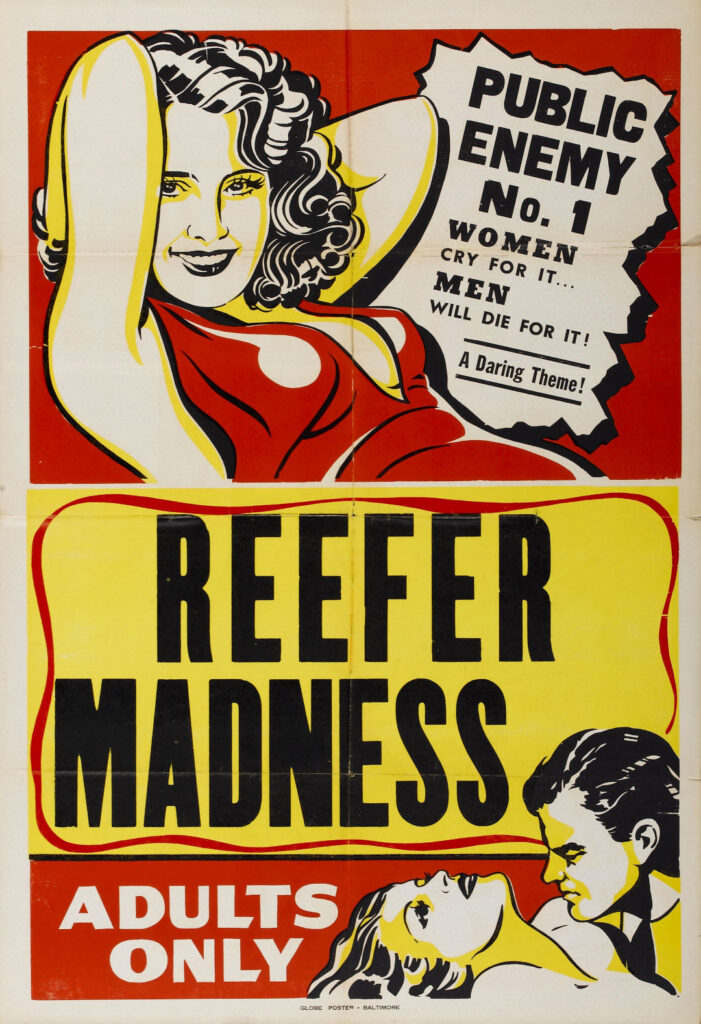
Reefer Madness (1936)
Reefer Madness (originally made as Tell Your Children and sometimes titled The Burning Question, Dope Addict, Doped Youth, and Love Madness) is a 1936 American propaganda film about drugs, revolving around the melodramatic events that ensue when high-school students are lured by pushers to try marijuana – upon trying it, they become addicted, eventually leading them to become involved in various crimes such as a hit and run accident, manslaughter, murder, conspiracy to murder and attempted rape. While this is all happening they suffer hallucinations, descend into insanity, associate with organized crime and (in one character’s case) commit suicide. The film was directed by Louis J. Gasnier and featured a cast of mainly little-known actors.
Director – Louis J. Gasnier
Writers – Lawrence Meade (original story), Arthur Hoerl (screenplay), Paul Franklin (additional dialogue)
Cast –
Dorothy Short as Mary Lane
Kenneth Craig as Bill Harper
Lillian Miles as Blanche
Dave O’Brien as Ralph Wiley
Thelma White as Mae Coleman
Carleton Young as Jack Perry
Warren McCollum as Jimmy Lane
Pat Royale as Agnes
Josef Forte as Dr. Alfred Carroll
Harry Harvey Jr. as Junior Harper
Richard Alexander as Pete Daly, Pusher (uncredited)
Lester Dorr as Joe – Bartender (uncredited)
Edward LeSaint as The Judge (uncredited)
Forrest Taylor as Blanche’s Lawyer (uncredited)
Watch “Reefer Madness” (1936)
Plot
Mae Coleman and Jack Perry are a cohabitating couple who sell marijuana. The unscrupulous Jack sells the drug to teenagers over Mae’s objections; she’d rather stick to an adult clientele. Ralph Wiley, a sociopathic college dropout turned dealer, and siren Blanche help Jack recruit new customers. Ralph and Jack lure high school student Bill Harper and college student Jimmy Lane to Mae and Jack’s apartment. Jimmy takes Bill to a party where Jack runs out of reefer, and Jimmy, who has a car, drives him to pick up more. When they get to Jack’s boss’ “headquarters”, Jimmy asks for a cigarette as Jack gets out and he gives him a joint. By the time Jack returns, Jimmy is unknowingly high; he drives away recklessly and hits a pedestrian. A few days later, Jack tells Jimmy that the man died of his injuries and agrees to keep Jimmy’s name out of the case – if Jimmy will agree to “forget he was ever in Mae’s apartment.” As the police did not have enough specific details to track Jimmy down, he indeed escapes punishment.
Bill, whose once-pristine record at school has rapidly declined, has a fling with Blanche while high. Mary, Jimmy’s sister and Bill’s girlfriend, goes to Mae’s apartment looking for Jimmy and accepts a joint from Ralph, thinking it’s a regular cigarette. When she refuses Ralph’s advances, he tries to rape her. Bill comes out of the bedroom and, still high, hallucinates that Mary is willingly offering herself to Ralph and attacks the latter. As the two are fighting, Jack knocks Bill unconscious with the butt of his gun, which inadvertently fires, killing Mary. Jack puts the gun in Bill’s hand, framing him for Mary’s death by claiming he blacked out. The dealers lie low for a while in Blanche’s apartment while Bill’s trial takes place. Over the objections of a skeptical juror, Bill is found guilty.
By now Ralph is paranoid from both marijuana and his guilty conscience. Blanche is also high; at one memorable point she plays the piano more and more rapidly as Ralph eggs her on. The boss tells Jack to shoot Ralph to prevent him from confessing, but when Jack arrives, Ralph immediately recognizes the threat and beats him to death with a stick as Blanche laughs uncontrollably in terror. The police arrest Ralph, Mae, and Blanche. Mae’s confession leads to the boss and other gang members also being arrested. Blanche explains that Bill was innocent and agrees to serve as a material witness for the case against Ralph, but instead, she jumps out of a window and falls to her death, traumatized by her own adultery and its role in Mary’s death. Bill’s conviction is overturned, and Ralph, now nearly catatonic, is sent to an asylum for the criminally insane for the rest of his natural life.
The film’s story is told in bracketing sequences at a lecture given at a PTA meeting by high school principal Dr. Alfred Carroll. At the film’s end he tells the parents he has been told that events similar to those he has described are likely to happen again, then points to random parents in the audience and warns that “the next tragedy may be that of your daughter… or your son… or yours or yours…” before pointing straight at the camera and saying emphatically “… or yours!” as the words “TELL YOUR CHILDREN” appear on the screen.